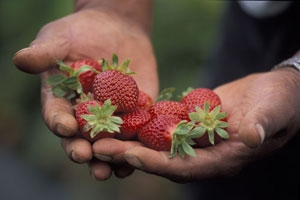
Now a two-year evaluation of California strawberries has found that organic strawberries, while lower in phosphorus and potassium, had significantly higher “antioxidant activity and concentrations of ascorbic acid [vitamin C] and phenolic compounds, longer shelf life, greater dry matter, and for ‘Diamante’, better taste and appearance” than conventionally grown berries.
The study has been getting a lot of media attention, including coverage in the L.A. Times, Seattle Times and National Public Radio.
Published in the September 2010 issue of PLoS ONE, an open-access, peer-reviewed journal, the study looked at 13 pairs of commercial organic and conventional strawberry agroecosystems. The fields were all in the Watsonville area, where 40 percent of California strawberries are produced. All of the paired farms had been in production at least five years and had comparable soil types. The researchers collected multiple samples in 2004 and 2005, and evaluated the strawberries for minerals, shelf life and phytochemicals. A sensory panel compared the organoleptic properties of three different varieties of fruit.
Regarding post-harvest durability, the organic berries — despite no fungicide applications — had significantly less gray mold and significantly less loss of fresh weight two days after harvest than conventional berries.
“These results indicated that the organic strawberries have a longer shelf life than conventional strawberries because of slower rotting and dehydration, perhaps due to augmentation of cuticle and epidermal cell walls,” the authors wrote.
Mark Bolda, UC Cooperative Extension farm advisor for strawberries in Santa Cruz County, said there are a number of variables that could account for a reduction in gray mold infestation.
“For example, organic plants are smaller in size, have a smaller canopy and consequently are drier because of more air circulation,” Bolda said. “Flowers and fruit subsequently present a drier and less appealing host for this fungus.”
Not surprisingly, the study found that “soils on the organic farms had significantly more carbon and nitrogen, greater microbial biomass and function, and great functional gene abundance and diversity.” The authors attributed this to the fact that the conventional sites were fumigated with methyl bromide and treated with synthetic pesticides, while the organic sites were not and received double the amounts of compost.
The researchers were affiliated with Washington State University, Pullman; Utah State University, Logan; Oak Ridge National Laboratory, Oak Ridge, Tennessee; and University of Oklahoma, Norman.
U.S. consumers continue to clamor for organic foods, sales of which have increased nearly six-fold since 1997 to $21.8 billion in 2008 (3 percent of total U.S. food sales). California produces 87 percent of the nation’s strawberries, of which nearly 5 percent are organically grown.